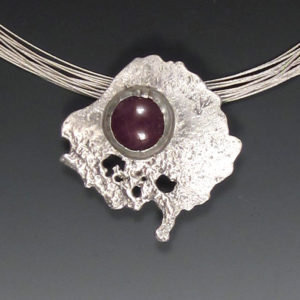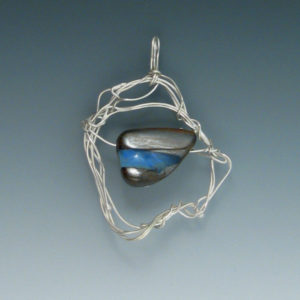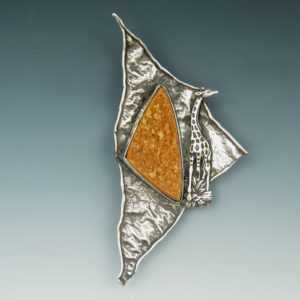My collections feature unusual stones and minerals in natural settings that highlight their inherent qualities. I scour the world for luscious colors and textures of mineral and stone specimens and then shape them into wearable pieces by cutting, trimming, and polishing them in the lapidary studio. I don’t use the most “precious” of specimens, preferring instead those that illustrate the physical properties of the mineral or stone. My goal is for the user (and their admirers) to see how the crystals grow and the natural habitat of the minerals.
The metal I use all starts as recycled/repurposed sterling silver. Other artists’ scraps, old jewelry, and reclaimed sterling from refiners are all great sources and keep me from contributing to the environmental hazards of mining. After I clean it up, I have fun melting it and seeing what happens. I let the silver “do its will” as much as possible, trusting that the forms it creates will be a perfect match for a mineral specimen (even if I haven’t found the stone yet ;-). Part of the definition of “Organic Silver” is that the shapes that the metal takes are based on its physical properties and how they react to the environment that day.
All of the pieces are handmade, one-of-a-kind, and use all natural materials. Many of them are parts of series or collections that use similar materials and a select number can be “re-created,” thought not “reproduced.” My customers enjoy knowing that they are wearing something truly unique. I do all of the lapidary and metal work in my studios in Palo Alto.
I have four (so far) different ways of playing with molten sterling: splats, flaps, wraps, and scraps. These terms are very technical so I am including example photos :-).
Splats are melted in a crucible and dripped on a stainless steel block (on which they cool instantly) or melted on a fire brick and splattered with a rock.

Flaps start off as stray pieces of sheet sterling to which I put the torch and watch it reticulate (burble as the different components of sterling heat differentially), form holes, and otherwise distorts.

Wraps are nests of wire melted together at intersections and are ideal for holding and displaying specimens that are fabulous in all directions and/or change color as they move.

Scraps are bits of old jewelry that I re-purpose either as a base or an accent to a piece.

The final step is to create a marriage between a particular specimen I have prepared and a silver vessel worthy of its natural beauty. Most of my pieces to date have ended up as pendants and earrings, though I also make (mostly adjustable) rings, wrist cuffs, belt buckles, brooches and even cuff links.
